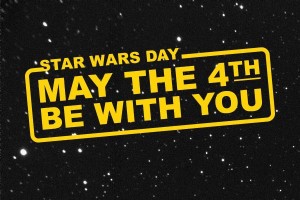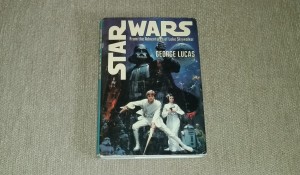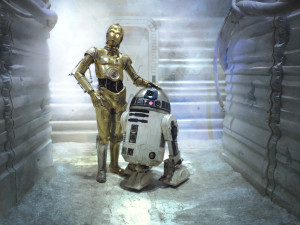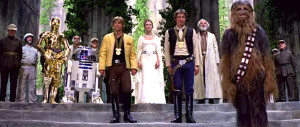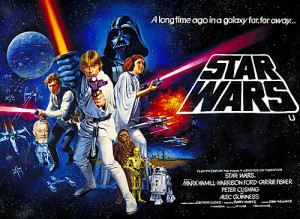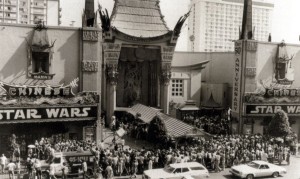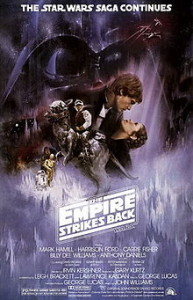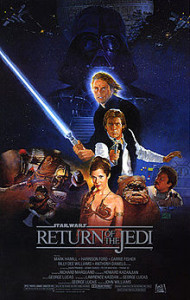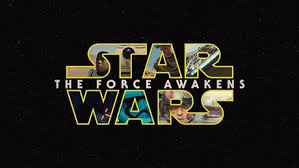“May The Fourth Be With You” is considered by fans to be the unofficial Star Wars Day. The date was chosen because off the word play on the famous phrase from the Star Wars series … “may the Force be with you”. The Force is an energy field that connects all living things and can be used to bring change to the spirit of the Galaxy. The phrase was used in the context of the films to wish people goodwill in parting or before going into battle.
The Star Wars movie series was created by George Lucas and the first film, “Star Wars” was released on May 25, 1977. It was followed “The Empire Strikes Back” in 1980 and then “Return of the Jedi” in 1983. These three highly successful films are considered the original Star Wars trilogy which when combined earned over $4 billion. Then, after a span of 16 years, “Phantom Menace” was released in 1999, followed by “Attack of the Clones” in 2002 and “Revenge of the Sith” in 2005. These three films in the franchise are considered the prequel trilogy which never seemed to reach the same commercial success as the original films. Last year the highly anticipated “The Force Awakens” was released and it continues the Star Wars story, is the first of three movies that will follow the characters into the years after “Return of the Jedi” (I guess you could say it is the “post” trilogy!)
In this post I will mainly discuss the original trilogy of the epic Star Wars series. So let’s get started … “a long time ago in a galaxy far, far away”.
The History of the Star Wars Movie Series
After George Lucas mild success with the 1973 film “American Graffiti” he decided that Lucasfilm’s next film would be a science fiction adventure story. He began writing a rough draft inspired by a relatively obscure 1958 film called “The Hidden Fortress” by Japanese filmmaker Akira Kurosawa (Lucas had recently graduated from the University of Southern California’s School of Cinematic Arts in 1967 and possibly saw the film as part of his Fine Arts courses). Between 1973 and 1976, several versions of the proposed science fiction film were written and various elements of the original story were changed, added or deleted. The name of the main character’s changed from Annikin Starkiller to Luke Starkiller to finally Luke Skywalker. As a result of the name change, the working title of the film also changed from the “Adventures of Luke Skykiller” to “The Star Wars” and then shortened to simply “Star Wars”. (Interesting Note: After the financial success of the first film, Lucas was able to create an independent film production company which would be separate from the typical Hollywood studio system. This would allow him complete control over his future films and he would eventually build a large complex for Lucasfilm in Marin County which he named Skywalker Ranch)
By 1976, Lucas had a final draft for the movie completed involving not only Luke but a an entire cast of characters including Princess Leia as a member of the Rebel Alliance, two robotic droids named C3PO and R2D2, Obi-Wan Kenobi a former Jedi Knight, Han Solo and Chewbacca as the renegade crew of the Millennium Falcon and the mysterious and sinister character of Darth Vader who is a member of the opposing Galactic Empire. (Interesting Note: Many months prior to the release of the original Star Wars movie, a book titled “Star Wars: From the Adventures of Luke Skywalker” was published in November 1976 by Ballantine Books. Alan Dean Foster was hired to write the book based on Lucas’ screenplay, although Lucas is credited as the author. It is unclear as to whether the book was part of Lucas’ plan for marketing his upcoming movie but the initial print run sold 125,000 copies. The photo shown below is my personal copy of the book that I happened to have stumbled upon a few years ago in an antique store, needless to say, I quickly purchased the book for under $10)
The first Star Wars movie (later re-titled “Star Wars: Episode IV – A New Hope”) cast consisted of relatively unknown actors in the three principal parts. Mark Hamill played Luke Skywalker, Carrie Fisher was Princess Leia and Harrison Ford was Han Solo. Ford had previously played a minor role in Lucas’ other film, American Graffiti. Alec Guinness played ObiWan, Guinness was an established British stage and film actor who was hired to please the studio because they were concerned about the cast of unknown actors. David Prowse played the role of Darth Vader but James Earl Jones gave the character its voice. Peter Mayhew played the 200 year old Wookie named Chewbacca, Han Solo’s first mate on the Millennium Falcon. Anthony Daniels played C3PO the protocol droid that is programmed to speak over six million languages. Kenny Baker played R2D2 the droid that Princess Leia entrusts with the Death Star plans and also a special message for Obi-Wan.
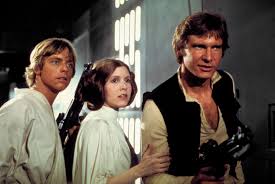
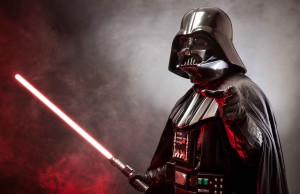
The next phase of pre-production was scouting the locations for filming, creating the sets, models and background paintings as well as deciding on the final costumes for the various characters. Lucas had a very distinct vision for the film and he worked closely with the designers at Elstree Studios in England styling the 30 different sets required for the film and selecting the props using a very small budget. For the complicated visual effects, Lucas formed Industrial Light & Magic (ILM) which worked in a large warehouse in Van Nuys, CA. The effects needed to give the illusion of spaceships traveling through the galaxy that were developed using digital motion control photography created by John Dykstra and his team. (Interesting Note: Despite the fact that Dykstra won an Academy Award for Best Visual Effects for his work on the first Star Wars film, Lucas had fired him from ILM over creative differences)
The filming schedule was set to have three separate units filming simultaneously at various locations. Principal photography began in March 1976 in the Tunisian desert in North Africa was used for the scenes of Tatooine, Death Valley National Park was also used for some Tatooine scenes. Tikal National Park in Guatemala was used for the scenes of the Fourth Moon of Yavin Rebel base. Elstree Studios is where the Millennium Falcon, Death Star and several other interior scenes were filmed while at Shepperton Studios in Surrey, England the final awards ceremony scene in the film was shot on the large Stage H.
The final phase was post-production in which the visual effects involving the space sequences were being completed by ILM and sound effects were added by Ben Burtt, who won an Oscar for Special Achievement for Sound Effects Editing. The famous lightsaber battle scenes were choreographed by Bob Anderson and the lightsaber effects as well as R2D2 were created by John Stears, who won an Oscar for Best Visual Effects. (Interesting Note: The lightsaber was the sword-like weapon used by the Jedi Knights and the Sith. The lightsabers had specific colors, such as the green lightsaber was used by Luke Skywalker and other Jedi Knights. The red lightsaber was used by Darth Vader and other members of the Sith. The blue lightsaber was used by Obi-Wan and the other Jedi Guardians or by Jedi Knights with higher powers)
When Lucas was in need of a composer for the first Star Wars film, Stephen Spielberg recommended John Williams who he had previously worked with him on his 1975 movie “Jaws”. The Star Wars soundtrack was performed by the London Symphony Orchestra, with Williams conducting, at the Anvil Studios in Denham England recorded in March 1977. The memorable Star Wars film score known as “Luke’s Theme” won the Academy Award for Best Original Score and the soundtrack album won the Grammy for Best Score Soundtrack for Visual Media. (John Williams would eventually compose all the music for the Star Wars movie series)
Finally, Star Wars written and directed by George Lucas was released on May 25, 1977 into fewer than 40 theaters nationwide and Lucas was so convinced that the movie would fail that he planned a trip to Hawaii to distract him on opening weekend. While in Hawaii, Lucas watched the evening news reporting on the large crowds queuing up at the movie theaters to see the movie but it wasn’t until it was finally confirmed that Star Wars had overwhelming broke box office records that Lucas realized his “little science fiction film” was not only a huge hit but it had just made him a very wealthy man! (Interesting Fact: After visiting the set of his friend and fellow director Spielberg’s “Close Encounter of the Third Kind”, Lucas had serious doubts about the success of his own film and felt that Close Encounters would be more successful than Star Wars. Spielberg disagreed and he felt Star Wars would be the bigger hit. To settle the disagreement, Lucas proposed that each would trade 2.5% of the profit of each other films. Well, the bet turned out to be very profitable for Spielberg who still receives his share of the profits from Star Wars)
To celebrate the enormous success of Star Wars, the film had an unprecedented second opening at the famous Grauman’s Chinese Theatre on August 3, 1977 in Los Angeles, CA. During the festivities attended by thousands of people there was a special ceremony in which C3PO, R2D2 and Darth Vader placed their “footprints” in front of the theater, an honor usually received for established Hollywood movie actors.
The second film of the original trilogy was “The Empire Strikes Back” which was released on May 21, 1980. The film was directed by Irvin Kershner, screenplay by Leigh Brackett and Lawrence Kasdan from a story by George Lucas. Lucas was the executive producer, overseeing all aspects of the production. The film continues the story of Star Wars as the Rebel Alliance has relocated to the ice planet of Hoth to escape the Galactic Empire. Luke soon leaves to train with the Jedi Master named Yoda (Frank Oz was the puppeteer and voice of Yoda, the puppet was created by Stuart Freeborn while Warwick Davis appeared in costume for the walking scene) Meanwhile, an old friend of Han’s named Lando Calrissian (played by Bill Dee William) unfortunately turns Han, Leia, Chewbacca and C3PO over to Darth Vader and Han is frozen in a block of carbonite. Before this happens, Leia confesses her love for Han and he famously responds, “I know”. Back on Dagobah, sensing that his friends are in serious danger Luke is faced with the decision to complete his training to become a full Jedi Knight or to save his friends. Luke leaves Yoda to confront Vader who tries to persuade him to join the Empire and the dark side. During their lightsaber battle Vader severs Luke’s right hand and in the end Vader confesses that he is Luke’s father. (Interesting Note: This major plot twist’s backstory was that Vader, previously known as Anakin Skywalker, was a former Jedi student of Obi-Wan Kenobi that been turned to the dark side. In an attempt to protect Luke, Obi-Wan had sent him to Tatooine and that is where we find him at the beginning of Star Wars living with Aunt and Uncle)
The third film of the original trilogy was “Return of the Jedi” which was released on May 25, 1983. The film was directed by Richard Marquand, screenplay by Lawrence Kasdan and George Lucas. The film opens with the Galactic Empire constructing a second Death Star in the orbit above the planet of Endor; the first Death Star was destroyed in the Battle of Yavin by Luke Skywalker in the original Star Wars film. Seeing an opportunity, the Rebel Alliance plans an attack on the incomplete space station and to also eleminate Emperor Palpatine (played by Ian McDiarmid) who is onboard overseeing the final stages of the Death Star II construction. On Endor the Rebels are hoping to deactivate the protective shield of the Death Star as part of their attack plan. Meanwhile, Luke is coming to grips with the fact that Darth Vader (a former Jedi Knight named Anakin Skywalker) is his father and he struggles with this knowledge that Anakin had turned to the dark side. In the Battle of Endor, the Rebels are victorious in destroying the Death Star and killing the Emperor. Darth Vader also dies but before he does he tells Luke that Leia is his daughter. Saddened by the death of Vader, Luke returns to Endor to tell Leia that she is his sister. In the end, Leia tells Han that she loves Luke because he is her brother, this news shocks him but it also makes him very happy because has come to the realization that he has fallen in love with Leia. (Interesting Note: After “Empire Strikes Back” completed filming in 1980, it was uncertain as to whether Harrison Ford would return in his role as Han Solo since he had only signed a contract for the first two Star Wars films. To add to the situation, Ford had become a huge star as “Indiana Jones”. This was the reason that Han was enclosed in the block of carbonite because the character could potentially be killed off to explain Ford’s absence. Lucas was against this idea and Ford renegotiated his contract for the last movie in the original trilogy)
As the “Return of the Jedi” moved toward completion, Lucasfilm had developed the THX sound system. Lucas had been unhappy with the sound quality of the movie theaters that showed his films and felt that a better sound system was needed. THX is a high-fidelity audio/visual sound system that would be compatible with any sound recording format whether digital or analog. Movie theaters needed to undergo a certification process requiring specific acoustic, technical and architectural standards to be able to use THX. When “Return of the Jedi” was in May 1983 it was the first film to use the THX sound system. (Interesting Note: The first theater install the THX system was the Norris Cinema Theatre located on the campus of the University of Southern California which was where Lucas graduated from the USC School of Cinematic Arts in 1967)
On a personal level, the making the original Star Wars trilogy effected not only Lucas health but also the state of his marriage. Lucas had worked through an extensive and exhausting schedule making of the three films which lead him to be diagnosed with hypertension and he was warned to reduce his stress levels. His demanding schedule also affected his marriage and by 1983 his wife had filed for a divorce. The final divorce settlement also affected his financial situation and he lost a large portion of the fortune he had earned. The ideas he had for the prequel trilogy were put on hold and he took a break from Star Wars, instead he worked with Spielberg as executive producer and story writer for the Indiana Jones film series.
In preparations for the 20th anniversary of the original Star Wars film in 1997 Lucas decided to re-release the trilogy into theaters. With the new special effects technologies in filmmaking, in particular computer generated imagery (CGI), Lucas felt he was now able to incorporate the visual effects and additional scenes that he was not able to achieve before in the original trilogy. With the renewed interest in the Star Wars franchise, Lucas decided to move forward with the prequel trilogy which elaborated on the backstory of Annakin SkyWalker and how he turned to the dark side. “Phantom Menace” was released on May 19, 1999, “Attack of the Clones” on May 16, 2002 and “Revenge of the Sith” was released on May 19, 2005.
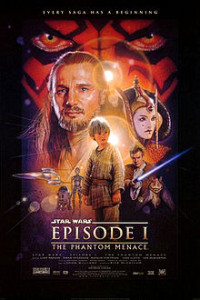
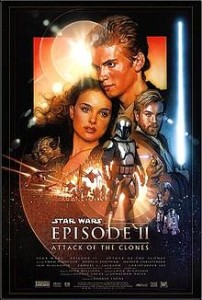
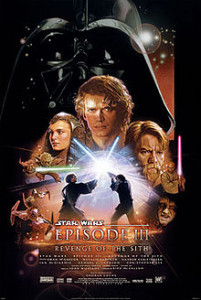
In January 2012, Lucas announced his retirement from producing major motion pictures. By June 2012, Kathleen Kennedy, was named co-chair of Lucasfilm. Kennedy had co-founded Amblin Entertainment with Steven Spielberg and Frank Marshall; she had previously worked with Lucas on the Indiana Jones series. Then when Lucas sold his company to the Walt Disney Company a few months later Kennedy became the president of Lucasfilm. At time it was also announced that there would three new Star Wars films. The sequel trilogy would continue the story of Luke, Leia and Han Solo. The first film in that trilogy, “The Force Awakens”, was released on December 18, 2015. (Interesting Note: 20th Century Fox retained the physical distribution rights to the first two Star Wars trilogies, owning permanent rights for the original 1977 film and holding the rights to the other five films until May 2020. The Walt Disney Studios owns the digital distribution to all of the Star Wars films with the exception of the first original film.

